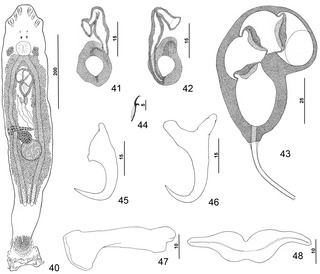
Pseudorhabdosynochus is a genus of monopisthocotylean monogeneans, included in the family Diplectanidae. The type-species of the genus is Pseudorhabdosynochus epinepheli .

Pseudorhabdosynochus regius is a diplectanid monogenean parasitic on the gills of the mottled grouper .

Pseudorhabdosynochus capurroi is a diplectanid monogenean parasitic on the gills of the Black grouper, Mycteroperca bonaci. It was described by Vidal-Martínez and Mendoza-Franco in 1998 and redescribed successively by Yang, Gibson and Zeng in 2005 and by Kritsky, Bakenhaster and Adams in 2015.

Pseudorhabdosynochus hyphessometochus is a diplectanid monogenean parasitic on the gills of the yellowmouth grouper, Mycteroperca interstitialis. It has been described by Kritsky, Bakenhaster and Adams in 2015.

Pseudorhabdosynochus sulamericanus is a diplectanid monogenean parasitic on the gills of the snowy grouper, Epinephelus niveatus, the Warsaw grouper, Epinephelus nigritus and the Haifa grouper, Epinephelus haifensis. It has been described by Santos, Buchmann & Gibson in 2000, redescribed by Kritsky, Bakenhaster and Adams in 2015. and again redescribed by Chaabane, Justine, Gey, Bakenhaster & Neifar in 2016.

Pseudorhabdosynochus contubernalis is a diplectanid monogenean parasitic on the gills of the Scamp, Mycteroperca phenax. It has been described by Kritsky, Bakenhaster and Adams in 2015.

Pseudorhabdosynochus mycteropercae is a diplectanid monogenean parasitic on the gills of the tiger grouper, Mycteroperca tigris (Serranidae). It has been described by Kritsky, Bakenhaster and Adams in 2015.

Pseudorhabdosynochus beverleyburtonae is a diplectanid monogenean parasitic on the gills of the dusky grouper, Epinephelus marginatus. It has been described by Guy Oliver in 1984 as Cycloplectanum beverleyburtonae, redescribed by Oliver in 1987, transferred to the genus Pseudorhabdosynochus by Kritsky & Beverley-Burton in 1986 as Pseudorhabdosynochus beverleyburtonae, redescribed by Kritsky, Bakenhaster and Adams in 2015, and redescribed in 2016 by Chaabane, Neifar, Gey & Justine.
Pseudorhabdosynochus calathus is a diplectanid monogenean parasitic on the gills of the grouper Epinephelus rivulatus. It has been described in 2006.

Pseudorhabdosynochus hayet is a diplectanid monogenean parasitic on the gills of the mottled grouper .

Pseudorhabdosynochus bouaini is a diplectanid monogenean parasitic on the gills of groupers. It has been described in 2007 by Lassad Neifar & Louis Euzet. The species has been redescribed by Amira Chaabane, Lassad Neifar, and Jean-Lou Justine in 2017.

Pseudorhabdosynochus dolicocolpos is a diplectanid monogenean parasitic on the gills of groupers. It has been described in 2007 by Lassad Neifar & Louis Euzet. The species name refers to the size of the vagina and is derived from the Greek words “dolicos” meaning long and “colpos” vagina. The species has been redescribed by Amira Chaabane, Lassad Neifar, and Jean-Lou Justine in 2017.

Pseudorhabdosynochus enitsuji is a diplectanid monogenean parasitic on the gills of groupers. It has been described in 2007 by Lassad Neifar & Louis Euzet. The name of the species honours French parasitologist Jean-Lou Justine . The species has been redescribed by Amira Chaabane, Lassad Neifar, and Jean-Lou Justine in 2017, from the type-material and additional specimens.

Pseudorhabdosynochus sinediscus is a diplectanid monogenean parasitic on the gills of groupers. It has been described in 2007 by Lassad Neifar & Louis Euzet. The name refers to the absence of squamodiscs and is derived from the Latin “sine”, indicating absence, and “discus”, contraction of “squamodiscus”.

Pseudorhabdosynochus sosia is a diplectanid monogenean parasitic on the gills of groupers. It has been described in 2007 by Lassad Neifar & Louis Euzet. According to Neifar & Euzet, the name of the species refers to Sosia, who in Plautus’ comedy Amphitryon confronts his double, and to the resemblance of the vagina of P. sosia to that of P. beverleyburtonae.
Pseudorhabdosynochus quadratus is a species of diplectanid monogenean that is parasitic on the gills of the white-streaked grouper Epinephelus ongus. It was described in 2011.
Pseudorhabdosynochus chauveti is a species of diplectanid monogenean that is parasitic on the gills of the blue grouper Epinephelus cyanopodus. It was described in 2008.
Pseudorhabdosynochus cyanopodus is a species of diplectanid monogenean that is parasitic on the gills of the blue grouper Epinephelus cyanopodus. It was described in 2008.
Pseudorhabdosynochus podocyanus is a species of diplectanid monogenean that is parasitic on the gills of the blue grouper Epinephelus cyanopodus. It was described in 2008.

Pseudorhabdosynochus riouxi is a species of diplectanid monogenean parasitic on the gills of dusky grouper Mycteroperca marginata. It was described by Guy Oliver in 1986 as Cycloplectanum riouxi, then transferred to the genus Pseudorhabdosynochus by Santos, Buchmann & Gibson in 2000. The species has been redescribed by Chaabane et al. in 2017.

















